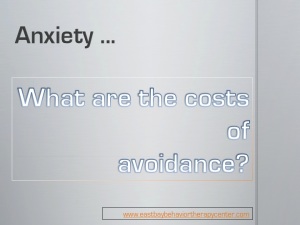Anxiety problems are one of the most common debilitating conditions in the United States; according to the Anxiety and Depression Association of America (ADAA), 40 million of people (adolescents and adults) struggle with one form of anxiety, and only one-third of them receive treatment despite anxiety being a highly treatable condition.
 Anxiety disorders across the board are characterized by mild to severe levels of avoidance. Avoidance can be situational, emotional, cognitive, or somatic (physical sensations). For instance in cases of panic disorder with agoraphobia, individuals are not avoiding the places per se; what they are really avoiding is experiencing their physical sensations, thoughts and emotions associated with panic in such places. Similarly, when people with obsessive-compulsive disorder avoid touching a doorknob that might have germs on it, what they’re really avoiding is the negative affect associated with touching the doorknob.
Anxiety disorders across the board are characterized by mild to severe levels of avoidance. Avoidance can be situational, emotional, cognitive, or somatic (physical sensations). For instance in cases of panic disorder with agoraphobia, individuals are not avoiding the places per se; what they are really avoiding is experiencing their physical sensations, thoughts and emotions associated with panic in such places. Similarly, when people with obsessive-compulsive disorder avoid touching a doorknob that might have germs on it, what they’re really avoiding is the negative affect associated with touching the doorknob.
Unfortunately, the more individuals engage in avoidant behaviors, the more likely they’re becoming prisoners of anxiety since a vicious cycle could be quickly developed, reinforced, and act as a maintaining factor of the anxiety problem.
Because of the debilitating aspects of anxiety and how often we work with clients struggling with it, during September last year (2012), we decided to start our anxiety group. Our first group had 7 participants, was time limited, and personalized to the point that each group member had a chance to face their specific fears. We met on a weekly basis, went over some of the exercises that were discussed the session before, and continue to learn to deal with anxiety in an effective way.
This year we’re offering the second annual anxiety group in August. Our clinical approach for this particular is based on two major empirically-supported treatments such as: Cognitive Behavior Therapy (Exposure based interventions in particular) and Acceptance and Commitment Therapy (ACT). Both therapy models have showed to be effective when dealing with all types of anxiety (Arch, J., Eifert, G., Davies,C., Vilardaga, R., Rose, R., & Crask, M.G. 2012).
The first part of the treatment will focus on psycho-education about anxiety, values identification, acceptance-based exercises, and preparation for exposure practices.
The second part of the treatment will focus on exposure exercises, including real life exposures targeting the individual needs of each client based on their exposure hierarchies.
If you would like more information about this group, please click HERE or contact us at 619-578-3974.



